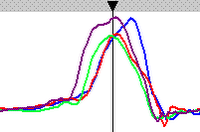More on Rowing Well For Boat Speed
 I came across a blog entry on Coach Thrasher that led me to a short analysis that provides some underpinning for the technique vs. erg discussion that the Pitt four's HOCR performance engendered. Of course, there are many factors that go into technique and no single factor is totally predictive, but this timing analysis provides one piece of the technique puzzle.
I came across a blog entry on Coach Thrasher that led me to a short analysis that provides some underpinning for the technique vs. erg discussion that the Pitt four's HOCR performance engendered. Of course, there are many factors that go into technique and no single factor is totally predictive, but this timing analysis provides one piece of the technique puzzle.
The charts relate to the oar pressure of rowers in a four. In "Coach Thrasher's" words, the underlying idea is that
"the force applied to the boat is the SUM of everyone rowing. If we can sum the peak-power for each rower at the same point in time, we'll get the MAXIMUM force applied to the water to move the boat forward the fastest. The higher this maximum force, the faster the boat will go, but the maximum force is the sum of everyone's efforts, so it's important to time it well. (Obviously there are many factors that contribute to boat speed as well, but this force-timing is really important in small boats.)"
"Note an important aspect of this: the boat will go faster by having the best timing, not by hammering the oar through the water! So a weaker crew with better timing will go faster than a stronger yet sloppy crew."
Now, take a look at the graphs. The difference is obvious, but at first may not seem terribly huge. We're told, however, that the better crew is going about 0.3 m/s faster, which works out to about 30 seconds over a 2000m course. Next, think about all the lightweight fours rowing over nearly 5000 meters at the HOCR. If Pitt's power application curve looked like that of the best crew in this analysis, and everyone else looked like the worst (not impossible), it would take a mighty strong crew to hammer the oar through the water hard enough to beat them.
This sort of thing can be difficult to see by the untrained observer, but that is why we have coaches and not personal trainers. As the Peach web site says, "A coach can identify these differences in terms of body movement, posture, sequencing of legs, trunk and arms during the drive etc."
There are a zillion other factors at play here, of course, and I have no idea if Pitt's advantage was power application timing. It may have been something else. For example, even within power application, the moment of maximum application is important too. The point is that seemingly small differences in technique and timing can make large differences in boat speed.

1 comment:
Great discussion here! With lightweight crews having "capped" power, the force-timing should be even more evident. You've got to be as efficient as you can with a limited engine.
have a good season!
Post a Comment